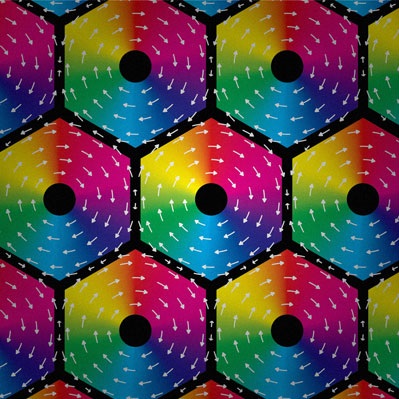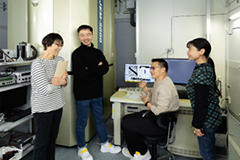Control of q-vector and mutual conversion between skyrmions and antiskyrmions via thermal currents
The spin whirl, magnetic skyrmion carrying a topological number −1, attracts much attention in fundamental physics and spintronics. As an antiparticle of skyrmion, the antiskyrmion exhibits opposite topological charge and unique spin texture composed of the alternating Bloch- and Néel-type spirals. In this study, we observed the dynamic behavior of helical structures, skyrmions (e) and antiskyrmions (d) under a temperature gradient ∇T in a magnetic material Fe1.9Ni0.9Pd0.2P (FNPP).
First, a 150nm-thick FNPP plate was fabricated, and Pt heater wires were attached to a silica (SiO2) substrate, connected to one end of the FNPP plate. Then, an insulating material, TEOS, was coated onto the SiO2 substrate (as shown in b). By passing a current through the heater wires, a lateral ∇T was induced within the FNPP. Upon applying ∇T to the helical structure with two q-vector (c) within the FNPP, the helical structure transformed into a single-q-vector helices. Furthermore, by applying a perpendicular magnetic field of 450 mT (mT) to the FNPP, followed by gradual reduction the field to zero, skyrmions were generated within the FNPP (e). The applying of ∇T causes the transformation of skyrmions into antiskyrmions (d).
These results demonstrate successful control over the helical magnetic structure, skyrmions, and antiskyrmions in FNPP using thermal currents.

a, Schematic of temperature gradient (∇T) in a magnetic domain structure. b, A scanning electron microscopy image of the Fe1.9Ni0.9Pd0.2P heating device used to demonstrate ∇T-induced transformations of a two modulation q-vector helical state (c) to a single q-vector alignment with zero magnetic field, a metastable skyrmion (e, topological charge N=-1) into an antiskyrmion (d,N=+1). d-e, Measured in-plane magnetic inductance maps of (down panel in c) helices with CW and CCW helicities aligned with modulation q-vectors parallel to the [110] and [1 ̅10] crystal axes, respectively, (down panel in d) an antiskyrmion and (down panel in e) a skyrmion. Scalebars 1 μm in (b) and 0.1 μm in (c-e).
Real-Space Observations of Three-Dimensional Antiskyrmions and Skyrmion Strings
The spin whirl, magnetic skyrmion carrying a topological number −1, attracts much attention in fundamental physics and spintronics. As an antiparticle of skyrmion, the antiskyrmion exhibits opposite topological charge and unique spin texture composed of the alternating Bloch- and Néel-type spirals. The present research aims to understand nontrivial 3D forms of topological objects and explore emergent electromagnetic properties in magnetic materials. We developed tomographic Lorentz TEM with a high spatial resolution (5 nm), and built an algorithm for 3D vector field reconstruction, allowing real-space observation of 3D topological spin textures, such as the deformed skyrmion string (Fig. 1a). Figure 1b shows the scalar field maps of some skyrmion strings in the top-view (upper panel) and cross-section view (down panel). The dual-tilt series of 2D Lorentz TEM images were employed to demonstrate a 3D vector field map of the antiskyrmion (Fig. 1c). Systematic analyses of the tilt series of Lorentz TEM images allow us to build 3D phase images (Fig. 1d) and the corresponding vector field maps of a single antiskyrmion and its cluster (Figs. 1e-f). Our exploits will lead to an advanced understanding of 3D spin textures in a broad class of magnets.

(a) Schematic of a deformed skyrmion string. (b) 3D scalar field map of some skyrmions strings observed in the top-view (upper panel) and the cross-section view (down panel) in a CoZnMn alloy. (c) The schematic of an antiskyrmion. (d-f) The 3D phase image (d) and corresponding vector field maps of antiskyrmions (e-f).
Direct observation of a single skyrmion and skyrmion cluster dynamics under pulse-current excitations
The magnetic skyrmion carrying a topological number −1, as a particle-like topological texture, attracts much attention in fundamental physics as well as in spintronics. The skyrmion Hall motion (a) occurs when the conduction electron passes through skyrmion due to the interaction of the electron and the Berry phase arising from skyrmion. Accordingly, the spin polarized electric current can drive skyrmion motion when its strength is above a critical value JC to overcome the pinning potential for the skyrmion in real materials. To manipulate small magnetic skyrmions, we set out working with a thin helimagnet FeGe with a notch hole, which allowed the spin current to be localized in a specific area near the corner of the notch and hence to generate isolated skyrmions and their cluster. The Hall motion companying a unique rotating motion (counter-clockwise in the present experimental setup; Figs. c-d) of the three-skyrmions cluster (Fig. b) has been demonstrated for the first time. Lorentz TEM observations (Figs. e-f) of pulse-current tracking a single skyrmion with 80-nm in diameter and their cluster demonstrated that the JC for drives of skyrmions in the thin FeGe is an order of 109 A/m2, three orders smaller than that for drives of magnetic domain walls in ferromagnetic materials.

(a) Skyrmion (colored vortices) Hall motion driven by electric currents. Longer arrows show current flow directions. (b-d) Lorentz TEM images of skyrmion Hall motion companying a rotation of skyrmion cluster with current-pulse excitations. (e-g) Lorentz TEM images of tracking a single skyrmion and a skyrmion cluster after several pulse-current excitations.
Directly imaging square lattices of atomic-scale skyrmions and nanometric antiskyrmions
The magnetic skyrmion carrying a topological number −1, as a particle-like topological texture, attracts much attention in fundamental physics as well as in spintronics. Skyrmions arising from Dzyalosinskii-Moriya interaction have been observed in several magnets with non-centrosymmetric crystal structures. Here we discovered atomic scale skyrmions causing by Ruderman–Kittel–Kasuya–Yosida (RKKY) interaction trough itinerant electrons in a magnet GdRu2Si2 with the centrosymmetric crystal structure. Figure 1a shows a square lattice of skyrmions (surrounded by dashed lines) observed at 8 K under a 1.95 T-field in a (001) thin plate of GdRu2Si2
On the other hand, a square lattice of square-shape antiskyrmions with topological number +1, has been observed in a (001) thin Mn1.4Pt0.9Pd0.1Sn (Fig. 1b). By tuning the external magnetic field and the temperature, the controlled transformations between antiskyrmios and elliptic skyrmions as well as their lattice forms have been demonstrated (Figs. 1b-1f). The in-plane field-controlled skyrmion helicity has also been revealed (Fig.1c, 1g).

(a) An underfocused TEM image observed at 8K under a 1.95 T-field in a (001) GdRu2Si2 thin plate. Circular domains surrounded by dashed lines show skyrmions, whereas small doted contrasts indicate crystalline elements. (b, c) Underfocused Lorentz TEM images for a square lattice of antiskyrmions (b) and for a triangular lattice of elliptic skyrmions (c) observed in a thin Mn1.4Pt0.9Pd0.1Sn. (d, e-f)Magnetization textures for a antiskyrmion (d), a skyrmion with counterclockwise helicity (e)and a skyrmion with clockwise helicity (f). (g) A triangular skyrmion lattice composed of elliptic skyrmions with unique helicity (counterclockwise).
Real-space observations of a square lattice of merons and antimerons
The topological spin texture, magnetic skyrmion indexed by an integer topological number, is of increasing interest in physical science and spintronics owing to its particle-like topological nature. On the other hand, meron (antimeron) carrying a topological number of ±1/2 is theoretically predicted but has not been experimentally confirmed yet in the helimagnets with the in-plane anisotropy. Here, the sequential real space observations of spin textures have been performed for a thin helimagnet Co8Zn9Mn3 with the in-plane anisotropy.
With application of a weak field (20 mT) at a room temperature (295 K), the real space images observed in the thin helimagnet directly demonstrate the formation of a square meron-antimeron lattice (sq-ML shown in Figs. 1(a)-1(b)). Such experimental results agree well with the theoretical predictions of the sq-ML. By finely increasing the magnetic field, the sq-ML transforms into a hexagonal skyrmion lattice (hex-SkL) (Fig. 1(c)-1(d)).

(a) A Lorentz TEM image and (b) the corresponding magnetization textures for a square meron-antimeron lattice realized in a chiral-lattice magnet Co8Zn9Mn3.
(c) A Lorentz TEM image and (d) the corresponding magnetization textures for a hexagonal skyrmion lattice realized in the same sample.
Real-space observations of nanometric-topological spin textures and their dynamics
The nontrivial phenomena, such as high-TC superconductivity and colossal magnetoresistance (CMR), are caused by electronic phase transitions in strongly correlated electron systems with weak external stimuli. Among them, skyrmion, i.e., nanometric topological spin texture arising from strong spin-orbit interaction is attracting much attention since it is considered to bear potential for future functional devices. In skyrmion, several hundreds of spins swirl with a unique direction and wrap a unit sphere. Particularly, skyrmion carrying a topological number can be driven by an extremely small current which is six orders of magnitudes lower than that for a drive of the domain wall in ferromagnets.
The emergent field induced by this nontrivial topological spin texture should deflect conducting electrons and hence cause novel magnetic transport phenomena such as the topological Hall effect. As a counteraction, the skyrmion Hall motion appears when the spin-polarized current traverses the skyrmion owing to spin transfer torque. By utilizing micro-fabrication techniques and in–situ Lorentz TEM observations, we have directly realized the topological spin textures and their dynamics in various materials hosting magnetic skyrmions.

Isolated skyrmions and recrystallization of isolated skyrmions in a helimagnet FeGe with a decrease of the magnetic bias-field. The left panel shows independent “isolated” skyrmions (white dots) at a higher bias-field, 425 mT. The right panel represents a mixed state of skyrmion crystal (SkX) and conical domains (C) with a reduction of the bias field from 425 mT to 150 mT.









